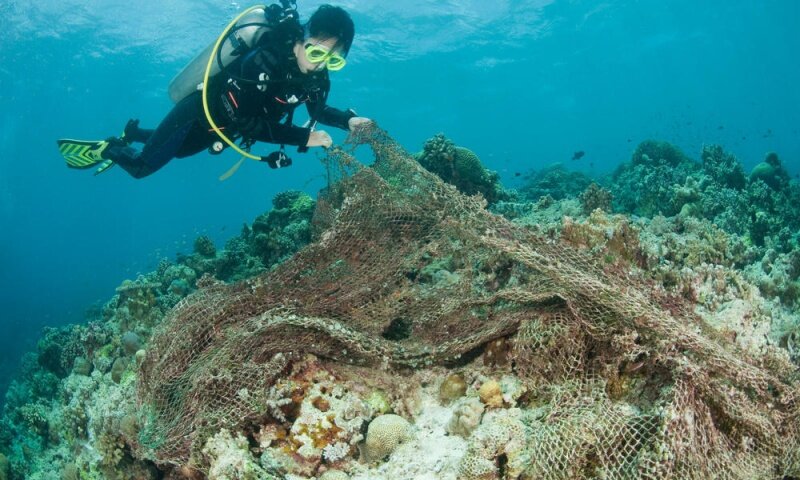‘Ghost Fishing’ is what fishing gear, mainly nets, lines, crab/shrimp pots, does when it has been abandoned in the ocean. Acting as designed, these nets or traps entangle fish, dolphins, sea turtles, seabirds and various other marine animals, limiting their movement and causing a vicious circle of death.
Ghost fishing
The term ‘Ghost fishing’ was first discussed in 1985 during a Food and Agriculture Organization (FAO) Committee on Fisheries in which an in-depth study revealed the devastation caused by gear fishermen loose, dump or abandon in oceans all over the world. Poorly operated drift nets were considered to be the primary source of ghost fishing and as a consequence were banned in 1992. Although this has somewhat reduced their contribution to this major environmental crisis, other equipment, such as for example bottom set gill nets which run anywhere from 600 to 10 000 meters in length, have taken their place. Another deadly problem are traps and pots. In the Chesapeake Bay of the United States for example, an estimated 150,000 crab traps are lost every year, and in just the single Caribbean island of Guadeloupe, about 20,000 of all traps set each year are lost during hurricane season. Unfortunately ghost fishing is an international problem that affects seas and oceans worldwide. In 2015 for example, a single mission by WWF in the Baltic recovered 268 tonnes of nets, ropes and other material.

In 2009, FAO and UN Environment Programme (UNEP). Released a second report in which experts proved how the problem of abandoned, lost or otherwise discarded fishing gear (ALDFG) is only worsening as time goes by. This is not only due to the increased scale of global fishing operations, but it’s also due to the introduction of highly durable fishing gear made of long-lasting synthetic materials, which can survive in the oceans for decades, possibly even centuries.
What causes ghost fishing?
The 2009 FAO and UNEP report, estimates that hundreds of kilometers of nets and lines are abandoned, lost or discarded each year, making up around 10% of all marine litter. Approximately 640,000 tonnes of litter floating around the oceans. The primary source of ghost fishing is merchant shipping, although we must say that the majority of abandoned gear has not been deliberately discarded. For the most part in fact nets are lost during storms or strong currents, they can be left tangled on rocky reefs, drift away in the open sea, or even get lost as a consequence of “gear conflicts”, meaning that the net was placed where bottom traps had already been deployed, therefore causing the nets to become entangled.
How does ghost fishing affect marine life?
Fishing nets, and in general gear used by fishermen, are specifically designed to catch fish or marine organisms when they are properly looked after. Once they become abandoned they become one of the biggest killers in our oceans. Imagine what nets and other equipment can do when left unattended.
Fish or dolphins or sea turtles or sharks, crocodiles, seabirds, crabs, and other creatures get tangled up, they then become restricted in their movement, unable to free themselves and unable to feed. They end up dying of starvation, laceration, infection, and, in the case of animals that need to surface to breathe, suffocation. Dead animals naturally attract scavengers which in turn also get caught in the nets, creating a vicious circle of death. Among the creatures affected by ghost fishing, we can also find corals. Nets can in fact break their brittle skeletons, destroy their soft tissue, and kill large chunks of the reef.

What can be done?
To help solve the problem a team of British, Portuguese, and Spanish organisations and universities, as well as various figures from the European fishing industry, has been working together on a project called NetTag.
This project aims to “reduce and prevent marine litter derived from fisheries, bringing together scientists, engineers and the fisheries industry” by developing new technology to prevent lost gears and raising awareness and educating fishermen about best-practices for on-board waste management.
Possible solutions could be to set up financial incentives to encourage fishermen to report lost gear or bring back to port old or damaged nets as well as encouraging them to recover fishing nets they might come across while out at sea.
GPS tracking could also be a solution to mark locations and retrieving lost gear, and other technology such as sea-bed imaging could avoid deploying nets where there are already traps or other visible obstacles that could later damage the gear.
A final solution that is underway is the use of bio-degradable materials. Fish traps and pots with biodegradable “escape hatches” already exist. Certain components of these traps disintegrate after a prolonged period of time under water, effectively rendering the traps harmless. Of course this would benefit marine life, but a retriever system would still need to be put in place in order to completely eliminate the level of debris caused.
